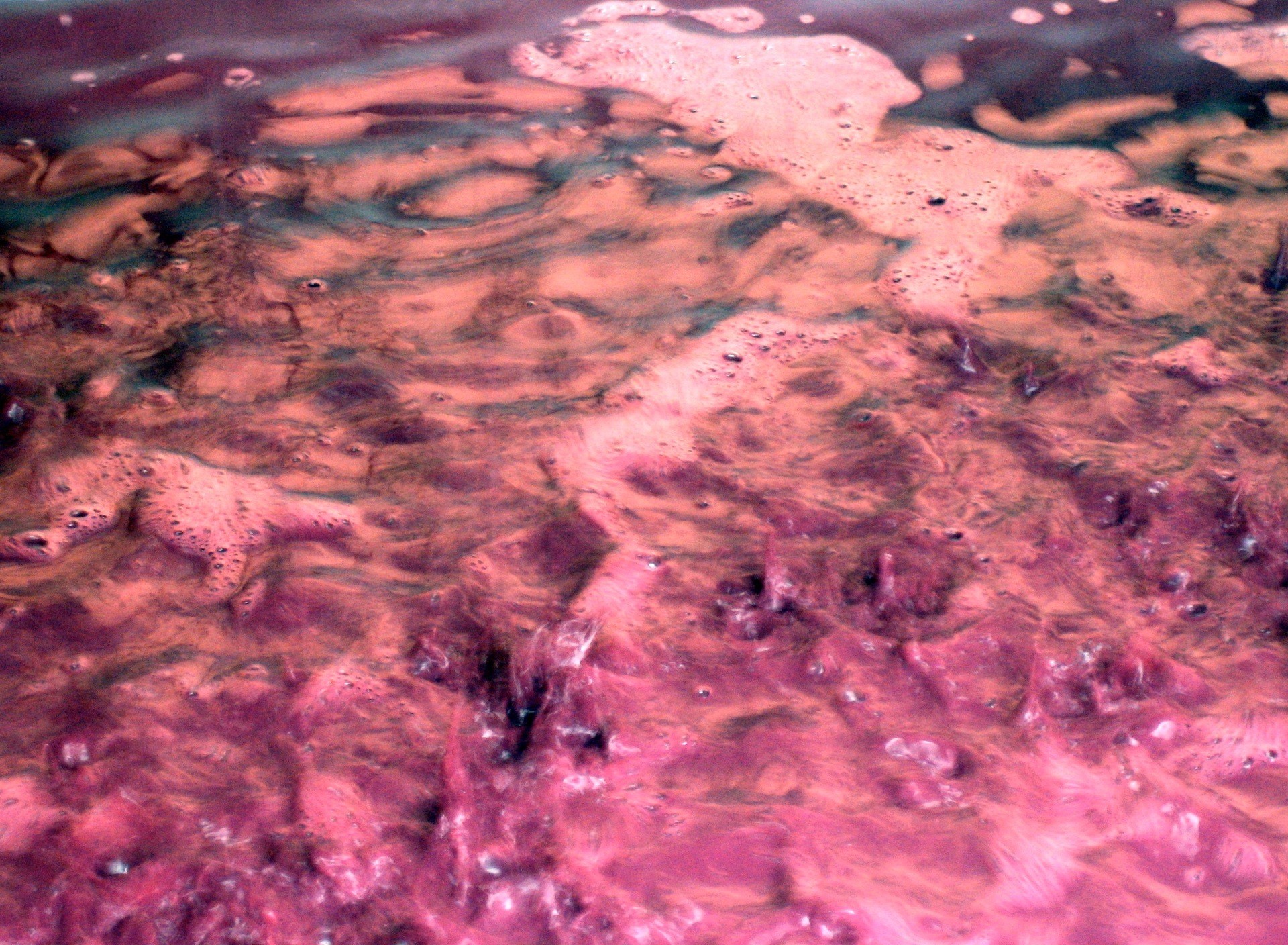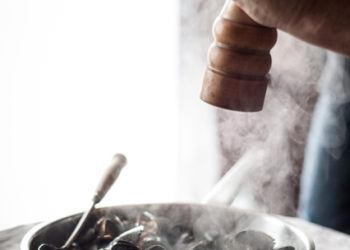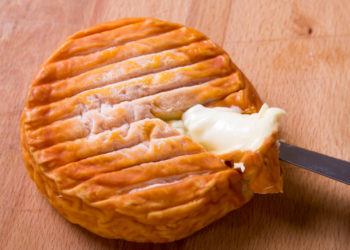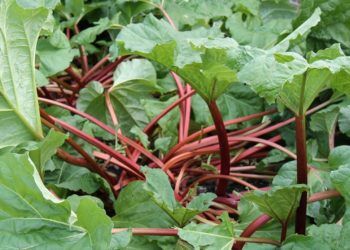A few years back, I was standing in line at an outdoor salmon barbecue. Now, I’m not one to stand in line for food, I am morally opposed to it, I just don’t do it. But there I was, at the International Pinot Noir Festival in McMinnville, Oregon. I had been drinking ‘91 and ‘92 pinot noirs from California and Oregon for two days. You could say I was in a pretty good mood, there in the company of several hundred pinot noir enthusiasts—a handful as fanatical as I. There are worse lines to stand in.
Now back to that queue. “Pinot noir is like . . . ,” I heard someone say. “Well, it’s like . . . .” The female voice hesitated, then grew softer, “it’s like, you know . . . sex.”
“Hmmm,” I wondered to myself, “what part, exactly, is she referring to.”
Such analogies abound about this sassy viticultural temptress, as I discovered when I realized my personal passion was shared by hundreds of salivating connoisseurs who think of pinot noir as not so much the ultimate wine experience as the ultimate experience. It wasn’t much later that I spotted an attractive little volume on the shelf at Cody’s Books: The Heartbreak Grape, the spine on a pretty hardcover volume read.
I felt like I’d been caught . . . But at what?
The Heartbreak Grape
I pulled it out, curious about the grape identified by the roguish adjective. “A California Winemaker’s Search for the Perfect Pinot Noir”, the subtitle read. It’s hard to explain why, but I flushed as a flood of emotions ripped through me: the thrill of discovery and anticipation, a hint of jealousy, a ripple of embarrassment. I felt like I’d been caught . . . But at what? Such is the dark, subterranean, erotic pull of pinot noir.
Soon, I was immersed in a tale of glorious obsession, on the part not only of Josh Jensen, the winemaker whose story is told, but also on the part of the author, Marq St. Villiers, who tells a story within a story, and another story within that: His, Jensen’s, and the tale of the provocative grape itself, which has enchanted winemakers for centuries and made fools of wine writers for decades.
Whence its power, its mystique? Heartbreak grape? Whose heart? How broken? How won in the first place? This compelling narrative held most if not all the answers.
Pinot noir is all human sex pheromones.
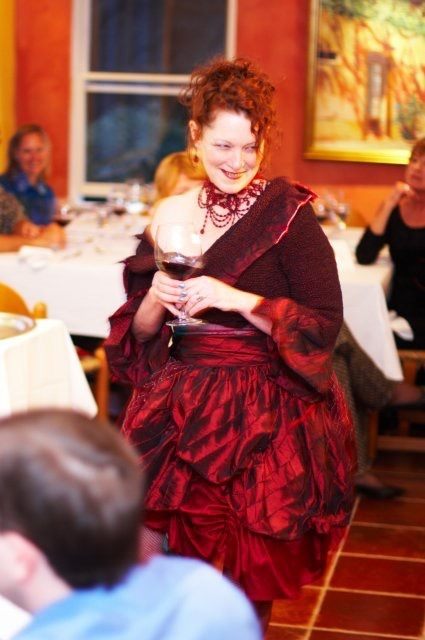
Seaweed Cafe, now closed, hosted a fashion show featuring Merry Edwards wines, with models representing five varietals. Here I am as pinot noir, in a creation by Miss Velvet Cream.
In southern Florida a few weeks earlier, I had attended a workshop by renegade winemaker Randall Graham of Bonny Doon Winery. He puts on quite a show, spiking his stream-of-consciousness narration with comments such as, “Friends don’t let friends drink chardonnay.” Graham takes his audiences on a wild ride, interupting himself constantly as he careens wrecklessly towards this outrageous story, that flamboyant observation, this contrary opinion.
When he launched his guided tasting of Bonny Doon’s Le Cigare Volante, a Rhone-style red named in honor of French legislation prohibiting the landing of “flying saucers or flying cigars”, by saying he began his career with an ultimately tragic longing to make pinot noir, I perked right up, eager to hear his take on what I had taken already taken as my enological paramour.
Midway through the talk Graham was discussing chemistry, saying how certain wines share molecular similarities with human sex pheromones. “In fact,” he says, interrupting his own story, “pinot noir is all human sex pheromones.”
How could his comments not set me thinking? If pinot noir is all human sex pheromones, I thought to myself as I made the long drive from Miami Beach to Key West, exactly what kind of sex does it inspire? Beaujolais, all fruitiness and low alcohol, is obviously safe sex. A bold zinfandel, a wreckless affair you know you’ll regret in the morning, fun now and then but not wise and rarely possible as a steady diet. Cabernet Sauvignon is an older man, often charming, but he takes himself so seriously and, oh, how he always insists on being in control. A good merlot, now that’s one of those rare perfect matches, like Paul Newman and Joanne Woodward, William and Catherine Blake, D. H. & Frieda Lawrence. Less common wines, say, the Italians and the Rhones, think of those few wonderful marriages your friends have made that you may not understand but, well, they seem so happy, maybe you should take a closer look.
Pinot Noir is Oscar Wilde, Mario Cuomo, & Marlena Dietrich, all in your living room at the same time.
But pinot noir, that you understand entirely: Pinot noir is the best sex you’ve ever had, the love of your life. But he’s gone now and every once in a while something happens and you . . . remember. Pinot noir is the James Dean of wine; it’s the wine women who love too much can’t drink. Pinot noir is Oscar Wilde, Mario Cuomo, and Marlena Deitrich, all in your living room at the same time. Pinot Noir is Cathy and Healthcliff; it’s Juliet on her wedding night. It’s Connie Chatterley in the rain wearing nothing but a pair of red shoes. Pinot Noir is Courtney Love in Frances Farmer’s wedding dress as she kisses her new husband Kurt Cobain, the tradewinds rustling their hair. It’s Roxy Music’s “The Thrill of it All”, Tim Buckley‘s “Sweet Surrender”, Nirvana’s “Aneurysm”; it’s Renata Tebaldi singing “Sogno di Doretta” from La Rondine. In its very finest vintages, pinot noir is Lord Peter Whimsey with Harriet Vane in a wine-red frock.

Pinot noir is often said to be a feminine wine but you can make a case that it is, now and then, masculine, in an old-school handsome, brooding sort of way, best expressed by the late actor David Janssen, especially in his role as Richard Kimble in The Fugitive.
I didn’t really want to do this. Americans are so damn trendy; we have such a legendary bandwagon tendency and I hate to encourage it. I don’t want pinot noir to become another thing, another trend, replacing all the cabernets on the wine lists, something people order because they know its name, because it makes them feel sophisticated, because they like the way the uppity waiter nods when they make their request. I want pinot noir to be a well-kept secret, a private society, a love affair so sweet, so delicious, so dangerous you keep it to yourself, smiling smugly at the thought of it until the real implications make you shiver.
You wonder, and then you take your first sip and you wonder no more because you, too, are transported.
You are at a dinner, most of your companions request chardonnay, a few ask for cabernet, except for a quiet man at the end of the table. You’ve already requested pinot noir. He quietly orders the same, a J. Rochioli Reserve, West Block, 1991. He looks at you and winks and later that night when you walk to your car, he’s watching you. Now, a smile appears when he takes his first sip. His eyes are open but his look is unfocused, far away. He is thinking of other things, or perhaps nothing at all, while the wine resonates. As you await your first taste you wonder what he’s thinking of, his first sweetheart, perhaps, or a first kiss. Someone he loved whom he had to leave behind, the turn of someone’s shoulders as she walked away for the final time, the curve of a neck, the feel of a hand upon a cheek. You wonder, and then you take your first sip and you wonder no more because you, too, are transported. Later, you will try to remember your thoughts, but you can only speculate because in truth there weren’t any. Only in retrospect do the analogies come. When the wine is upon your lips it’s all feeling and pleasure, all sensuality and emotion, sensation that may transport you to other times, but the transportation is corporeal not mental. It is visceral, palpable, and later when you try to remember it you may recall other times, other experiences, other loves that made you feel this way. But you can’t think of them as you drink the wine because it is too compelling: like great lovemaking you are fully in the moment and you awake in the morning happy and pleased with yourself. Few things are sweeter than a pinot noir hangover.
Lucky for those of us intoxicated by the ephemeral wonder of a perfect pinot noir, the grape is so perverse that it will never become the next big thing. It simply won’t cooperate on a grand enough scale to be that available. Don Baumhefner, back then a wine buyer, once said to me, “Ninety-eight percent of all pinot noirs should be thrown out; the rest are the finest wines in the world.” Like Apple Macintosh loyalists, pinot noir lovers don’t mind that the odds are against us.
I had gotten this far entirely on my own, without The Heartbreak Grape. Pinot noir and I had inhabited our own cozy little world. Now I have an insatiable interest not only in the grape and its juice, but in its intriguing story, its haunting ability to tantalize and mesmerize. St. Villiers quotes writers who forget themselves as they attempt to evoke their experiences of the famous grape of Burgundy. Consider Oz Clark’s word: “The flavors of the great red Burgundies are sensuous, often erotic, above rational discourse and beyond the powers of measured criticism as they flout the conventions in favor of something rooted in emotions and passions too powerful to be taught, too ancient to be meddled with.”
Joel Fleishman, vice president of Duke University, goes even further: “ . . .pinot noirs are the most romantic of wines, with so voluptuous a perfume, so sweet an edge, and so powerful a punch that, like falling in love, they make the blood run hot and the soul wax embarrassingly poetic.”
St. Villiers himself teeters precariously:
“It was December and there was a log fire crackling in the hearth. The room was painted in honey yellow; there were piles of books everywhere . . .The host took the bottle from his “cellar,” a small cupboard underneath the stereo, and pulled the cork without comment, pouring a little of the wine into glasses on the table. I remember that something struck me about its clarity, a brilliant red, like rubies under fire, and though my memory is probably colored by the warmth of the setting, I know I felt something …unusual…about it.”
As St. Villier’s weaves his tale, the story of making pinot noir, of winemaking itself, unfolds like a newly decanted bottle. Terms come into focus, clear and accessible at last, as he reveals the process of making such a temperamental wine. Chemistry is fascinating, as is cooperage, soil, limestone, water and the lack of it, every little thing necessary to encourage the touchy little grape as it turns itself into wine.
We learn that pinot noir is delicate and temperamental, that “. . . [it] mutates if you give it a cross look, seemingly out of pure spite.”
Pinot Noir as Scarlett O’Hara
Its perversity is legendary. Pinot noir as Scarlett O’Hara. “Some years the vines stubbornly refuse to set fruit, the flowers simply withering instead of turning to precious grapes. No one seems to know why.”
“The pinot noir grape,” St. Villiers tells us, “is as capricious as the vine. Its petulance comes from its thin skin. It needs regular sun to ripen, but will quickly overripen if the sun gets too hot. On the other hand, it can’t cope with too much rain. It will swell and burst and rot if it gets too wet at harvest time.”
Pinot noir resists submission—again, pinot noir as Courtney Love, widowed now but undaunted. Success often seems more a bestowing of grace by the grape than the achievement of the winemaker. Even if the winemaker is successful at every turn and succeeds in getting a superb liquid into the bottle, pinot noir is prone to an odd little affliction called bottle shock. It’s as if the delicate little thing faints dead away at finding itself so confined. Or perhaps it’s simply angry, and withholds all its complexity in a kind of temper tantrum, a mauvaise humeur du vin. It can take months before a wine shakes off the shroud of bottle shock and returns to its former self.
Buy merlot; it’s the next big thing.
I finished The Heartbreak Grape all too soon, a glass of Gary Farrell 1990 Russian River Valley Allen Vineyard Pinot Noir as my companion, but the story is far from over. The book itself has all but vanished from the shelves; I’ve heard there was a problem with plagiarism. Yet with the recent release of the 1994 pinot noirs , a new chapter is about to be added. Gary Farrell says the year is the best he’s seen since he became a winemaker in 1978. Every winemaker concurs, 1994 is the dream vintage. That’s both good news and bad, for the word is sure to spread. If I find my favorite wines gone before I stock up—and writers aren’t known for their extensive wine cellars—maybe I’ll learn to keep my mouth shut. So here’s my advice: Buy merlot; it’s the next big thing.
©1994micheleannajordan


